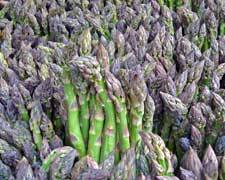
Compiled by HF Staff
 Photo by Ryan Freisling |
For a successful asparagus crop, consider these facts, tips and bits of history about this hardy perennial:
- Wild asparagus spears break through the ground in early spring. They look a lot like the ones you find growing in your garden, but the wild ones are a lot thinner, according to Susan Brackney in “Eat This, Not That,” Hobby Farms, May/June 2009. Wild asparagus, she says, can be “nibbled raw, steamed, roasted or grill, and it also can be pickled or frozen for long-term storage.
- A search on Dave’s Garden website indicates there are around 52 types of asparagus to choose from. The open-pollinated Mary and Martha Washington varieties continue to be the predominant ones offered by commercial seed houses.
- Choose the best variety available because–according to the University of Illinois Extension–an asparagus bed should remain productive for at least 15 to 20 years. If you are starting a new bed, you may never get to choose a variety again if your bed produces that long.
- Two common problems confronted by asparagus are asparagus beetles, which may be controlled by a suggested insecticide or by handpicking, and asparagus rust (mainly in the Midwest) says the University of Illinois Extension. It advises planting plant rust-resistant varieties. Mary Washington (a rust-resistant variety) is a standard variety for most home gardeners.
- Texas Agricultural Extension Service advises, because the plant yields 8 to 10 pounds or more per 100 square feet of bed or 24 to 30 pounds per 100 feet of row, one row is adequate for most home gardeners. It also advises placing crowns 12 to 14 inches apart. Planting too closely can cause small spears. (A few growers direct-seed asparagus. This method requires considerable expertise.)
- Do not harvest asparagus the first growing season after planting crowns. It can be harvested (cut) for short time (not to exceed two weeks) the second or third year. Weak plants and small spears result from harvesting too much, too early. After the second year after planting crowns, harvest asparagus from 6 to 8 weeks each year. Weak plants should be harvested for less time, according to North Carolina State University, Department of Horticultural Science.
- Asparagus is a good source of vitamin A and C, as well as riboflavin, niacin, and thiamin and the minerals iron, phosphorus, and potassium, report several extension agencies.
- The word asparagus comes from the Greek asparagos, meaning shoot or sprout.
- Records of human use of asparagus date back to the beginning of records, according to the University of Florida. Early Greek and Roman records detail growing instructions and medicinal uses. Greeks believed the plant could cure everything from toothaches to heart ailments. (California Asparagus Commission, 2005; Trowbridge, 2005; Rangarajan, 2005) The Roman emperors permanently employed people to collect asparagus from the wild and the upper class brought it with them as they conquered new lands (Boswell 1949; Austparagus, 2005). In the 1600s King Louis XIV of France ordered special greenhouses built for asparagus (Stradley, 2004).
- As of 2007, Peru is the world’s leading asparagus exporter, followed by China and Mexico. The top asparagus importers (2004) were the United States (92,405 tons), followed by the European Union (external trade) (18,565 tons), and Japan (17,148 tonnes), according to reports from the USDA and US Census Bureau.



